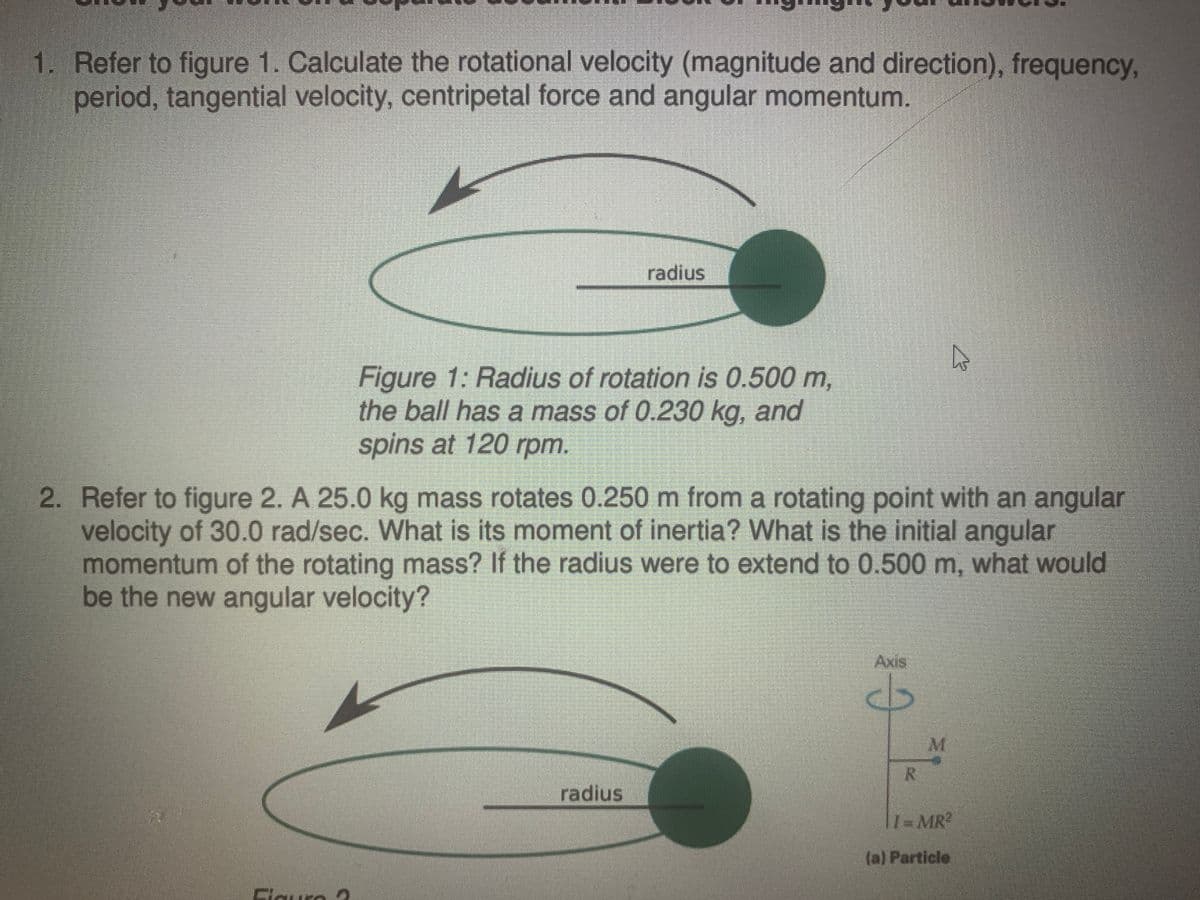1. Refer to figure 1. Calculate the rotational velocity (magnitude and direction), frequency, period, tangential velocity, centripetal force and angular momentum. radius Figure 1: Radius of rotation is 0.500 m, the ball has a mass of 0.230 kg, and spins at 120 rpm. 2. Refer to figure 2. A 25.0 kg mass rotates 0.250 m from a rotating point with an angular velocity of 30.0 rad/sec. What is its moment of inertia? What is the initial angular momentum of the rotating mass? If the radius were to extend to 0.500 m, what would be the new angular velocity? Axis
1. Refer to figure 1. Calculate the rotational velocity (magnitude and direction), frequency, period, tangential velocity, centripetal force and angular momentum. radius Figure 1: Radius of rotation is 0.500 m, the ball has a mass of 0.230 kg, and spins at 120 rpm. 2. Refer to figure 2. A 25.0 kg mass rotates 0.250 m from a rotating point with an angular velocity of 30.0 rad/sec. What is its moment of inertia? What is the initial angular momentum of the rotating mass? If the radius were to extend to 0.500 m, what would be the new angular velocity? Axis
College Physics
10th Edition
ISBN:9781285737027
Author:Raymond A. Serway, Chris Vuille
Publisher:Raymond A. Serway, Chris Vuille
Chapter8: Rotational Equilibrium And Rotational Dynamics
Section: Chapter Questions
Problem 13WUE: A basketball player entertains the crowd by spinning a basketball on his nose. The basketball has a...
Related questions
Question
#1 please show work so I can understand

Transcribed Image Text:1. Refer to figure 1. Calculate the rotational velocity (magnitude and direction), frequency,
period, tangential velocity, centripetal force and angular momentum.
radius
Figure 1: Radius of rotation is 0.500 m,
the ball has a mass of 0.230 kg, and
spins at 120 rpm.
2. Refer to figure 2. A 25.0 kg mass rotates 0.250 m from a rotating point with an angular
velocity of 30.0 rad/sec. What is its moment of inertia? What is the initial angular
momentum of the rotating mass? If the radius were to extend to 0.500 m, what would
be the new angular velocity?
Axis
M.
radius
T1-MR
(a) Particle
Cleura
Expert Solution
This question has been solved!
Explore an expertly crafted, step-by-step solution for a thorough understanding of key concepts.
This is a popular solution!
Trending now
This is a popular solution!
Step by step
Solved in 2 steps with 2 images

Knowledge Booster
Learn more about
Need a deep-dive on the concept behind this application? Look no further. Learn more about this topic, physics and related others by exploring similar questions and additional content below.Recommended textbooks for you

College Physics
Physics
ISBN:
9781285737027
Author:
Raymond A. Serway, Chris Vuille
Publisher:
Cengage Learning

University Physics Volume 1
Physics
ISBN:
9781938168277
Author:
William Moebs, Samuel J. Ling, Jeff Sanny
Publisher:
OpenStax - Rice University

Physics for Scientists and Engineers: Foundations…
Physics
ISBN:
9781133939146
Author:
Katz, Debora M.
Publisher:
Cengage Learning

College Physics
Physics
ISBN:
9781285737027
Author:
Raymond A. Serway, Chris Vuille
Publisher:
Cengage Learning

University Physics Volume 1
Physics
ISBN:
9781938168277
Author:
William Moebs, Samuel J. Ling, Jeff Sanny
Publisher:
OpenStax - Rice University

Physics for Scientists and Engineers: Foundations…
Physics
ISBN:
9781133939146
Author:
Katz, Debora M.
Publisher:
Cengage Learning

College Physics
Physics
ISBN:
9781938168000
Author:
Paul Peter Urone, Roger Hinrichs
Publisher:
OpenStax College

Glencoe Physics: Principles and Problems, Student…
Physics
ISBN:
9780078807213
Author:
Paul W. Zitzewitz
Publisher:
Glencoe/McGraw-Hill

College Physics
Physics
ISBN:
9781305952300
Author:
Raymond A. Serway, Chris Vuille
Publisher:
Cengage Learning